Unit 3 Diverse Cultures Reading for Writing课件 (共28张PPT) 2024-2025学年高一英语人教版(2019)必修3
文档属性
| 名称 | Unit 3 Diverse Cultures Reading for Writing课件 (共28张PPT) 2024-2025学年高一英语人教版(2019)必修3 |  | |
| 格式 | pptx | ||
| 文件大小 | 63.0MB | ||
| 资源类型 | 教案 | ||
| 版本资源 | 人教版(2019) | ||
| 科目 | 英语 | ||
| 更新时间 | 2025-05-22 17:30:50 | ||
图片预览

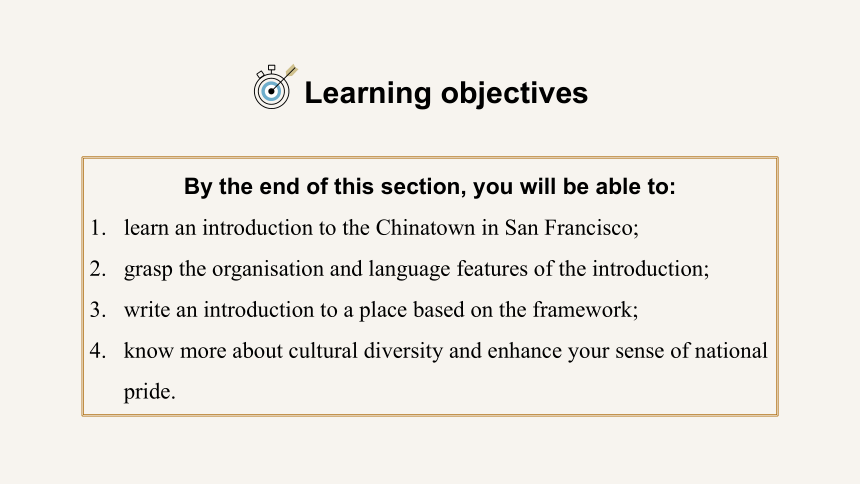
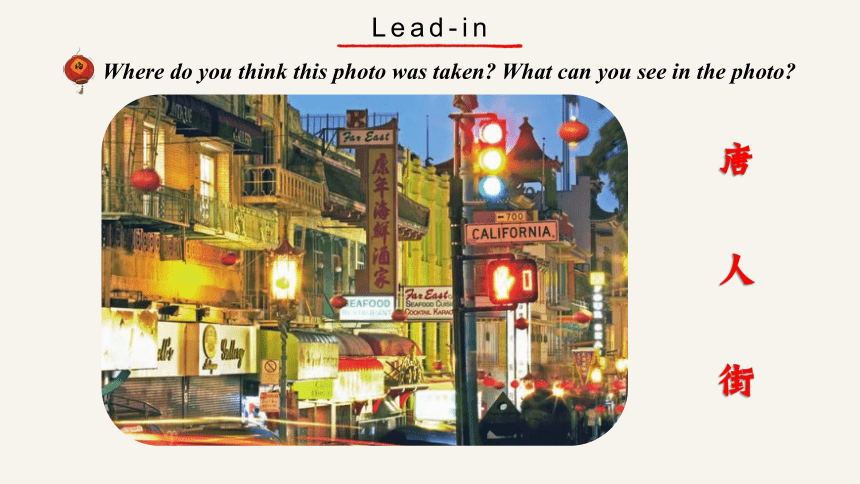
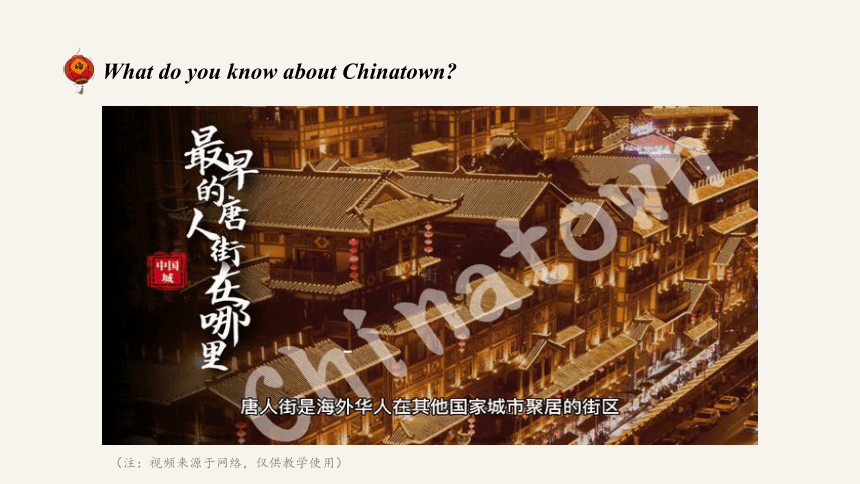

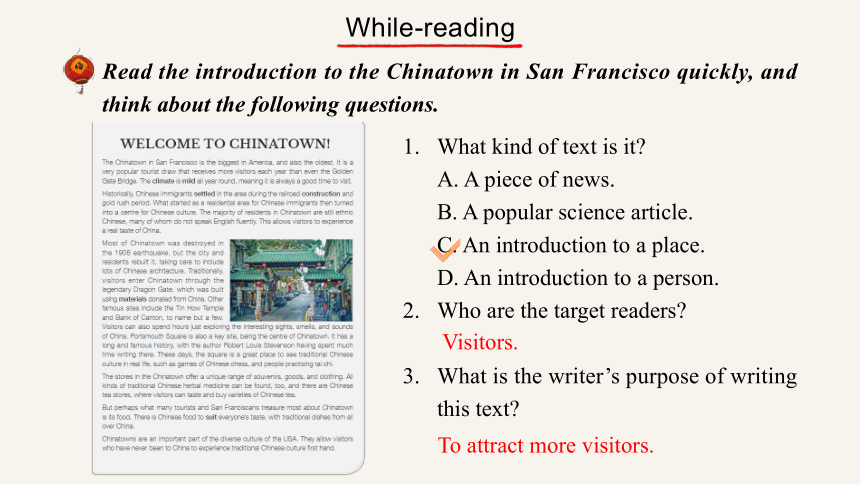

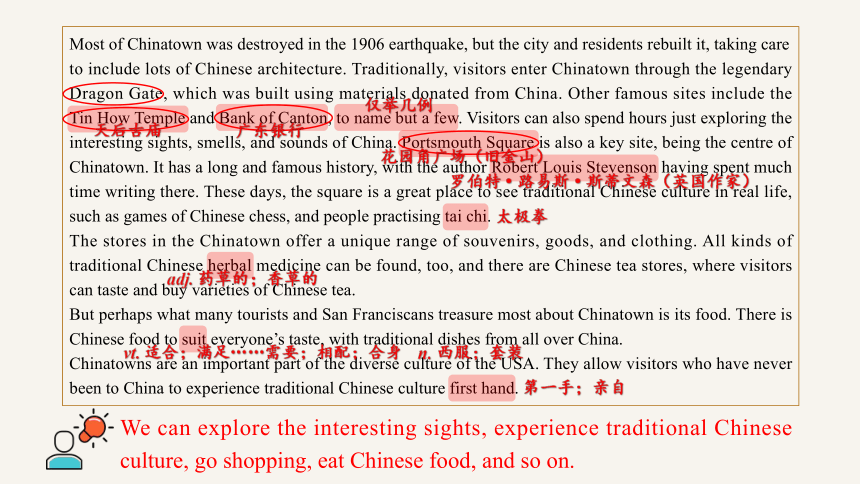
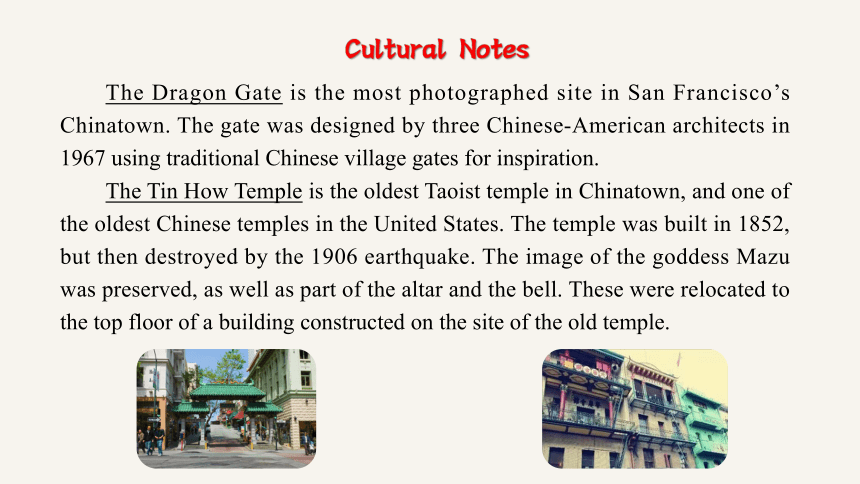
文档简介
(共28张PPT)
人教版(2019)必修三
Unit 3 Diverse Cultures
Reading for Writing
Describe a place with distinctive cultural identity
Learning objectives
By the end of this section, you will be able to:
learn an introduction to the Chinatown in San Francisco;
grasp the organisation and language features of the introduction;
write an introduction to a place based on the framework;
know more about cultural diversity and enhance your sense of national pride.
Lead-in
Where do you think this photo was taken What can you see in the photo
唐人街
What do you know about Chinatown
(注:视频来源于网络,仅供教学使用)
Pre-reading
What do you want to know about the Chinatown in San Francisco
(注:视频来源于网络,仅供教学使用)
While-reading
Read the introduction to the Chinatown in San Francisco quickly, and think about the following questions.
What kind of text is it
A. A piece of news.
B. A popular science article.
C. An introduction to a place.
D. An introduction to a person.
Who are the target readers
What is the writer’s purpose of writing this text
Visitors.
To attract more visitors.
Read the introduction carefully and answer the two questions: What are the famous tourist sites in the Chinatown of San Francisco What else can you do there
The Chinatown in San Francisco is the biggest in America, and also the oldest. It is a very popular tourist draw that receives more visitors each year than even the Golden Gate Bridge. The climate is mild all year round, meaning it is always a good time to visit.
Historically, Chinese immigrants settled in the area during the railroad construction and gold rush period. What started as a residential area for Chinese immigrants then turned into a centre for Chinese culture. The majority of residents in Chinatown are still ethnic Chinese, many of whom do not speak English fluently. This allows visitors to experience a real taste of China.
n. 气候
adj. 温和的;和善的;轻微的
vt. & vi. 定居;结束(争论);解决(纠纷)
n. 建筑;建造;建造物;(句子、短语等的)结构
Most of Chinatown was destroyed in the 1906 earthquake, but the city and residents rebuilt it, taking care to include lots of Chinese architecture. Traditionally, visitors enter Chinatown through the legendary Dragon Gate, which was built using materials donated from China. Other famous sites include the
Tin How Temple and Bank of Canton, to name but a few. Visitors can also spend hours just exploring the interesting sights, smells, and sounds of China. Portsmouth Square is also a key site, being the centre of Chinatown. It has a long and famous history, with the author Robert Louis Stevenson having spent much time writing there. These days, the square is a great place to see traditional Chinese culture in real life, such as games of Chinese chess, and people practising tai chi.
The stores in the Chinatown offer a unique range of souvenirs, goods, and clothing. All kinds of traditional Chinese herbal medicine can be found, too, and there are Chinese tea stores, where visitors can taste and buy varieties of Chinese tea.
But perhaps what many tourists and San Franciscans treasure most about Chinatown is its food. There is Chinese food to suit everyone’s taste, with traditional dishes from all over China.
Chinatowns are an important part of the diverse culture of the USA. They allow visitors who have never been to China to experience traditional Chinese culture first hand.
We can explore the interesting sights, experience traditional Chinese culture, go shopping, eat Chinese food, and so on.
天后古庙
广东银行
仅举几例
花园角广场(旧金山)
罗伯特·路易斯·斯蒂文森(英国作家)
太极拳
adj. 药草的;香草的
vt. 适合;满足……需要;相配;合身 n. 西服;套装
第一手;亲自
The Dragon Gate is the most photographed site in San Francisco’s Chinatown. The gate was designed by three Chinese-American architects in 1967 using traditional Chinese village gates for inspiration.
The Tin How Temple is the oldest Taoist temple in Chinatown, and one of the oldest Chinese temples in the United States. The temple was built in 1852, but then destroyed by the 1906 earthquake. The image of the goddess Mazu was preserved, as well as part of the altar and the bell. These were relocated to the top floor of a building constructed on the site of the old temple.
Cultural Notes
The Bank of Canton is actually the old Chinese Telephone Exchange, a traditional Chinese-style building constructed in 1894. When the telephone was first introduced, there was no way to dial a number. Instead, you would have to talk to a switchboard operator (nearly always a woman), tell her the telephone number of the person you wanted to talk to, and she would manually connect you to the person you wanted to call using an electric plug. However, Chinese residents thought it was impolite to use a number to refer to a person, so the switchboard operators in Chinatown had to know all the names and addresses of everyone in Chinatown so they would know who to connect people to. They also had to know five dialects of Chinese and speak English. Like many buildings in Chinatown, the Chinese Telephone Exchange was destroyed by the 1906 earthquake, but it was quickly rebuilt. However, in 1949 it was closed when dial telephones made switchboards unnecessary. The Bank of Canton bought and restored the building in 1960.
Portsmouth Square, now a public park, is the site of San Francisco’s first public square, built in the early 19th century. While many important historical events related to California and San Francisco occurred in the square before Chinatown was established or grew in size, the site is now very much considered an integral part of Chinatown.
short introduction to the San Francisco Chinatown
what you can find and do in the San Francisco Chinatown
importance of Chinatown
Introduction
Body
Summary
What’s the structure of the text
location
climate
history
population
famous figures
tourist attractions
ethnic groups
legends/
stories
businesses and industries
languages
famous food/drink
other names for the city/town
Para. 1
Para. 2
Para. 3
Paras. 4-5
What information is included in the introduction Tick the items that are mentioned.
n. 项目;一件商品(或物品);一条(新闻)
location
climate
history
famous figures
tourist attractions
ethnic groups
businesses & industries
languages
famous food/drink
Underline the sentences that are used to describe the items.
Para. 1
Para. 2
Para. 3
Paras. 4-5
Paragraph Main idea Details Expressions
1 Introduction
2-5 Body 2
3
4
5
6 Summary
short introduction to the San Francisco Chinatown
what you can find and do in the San Francisco Chinatown
importance of Chinatown
location, features, climate
biggest, oldest, very popular tourist draw, mild all year round
history, ethnic groups, language
historically…, what started as ... then turned into ..., the majority of residents ..., a real taste of China
attractions, famous figures
famous sites include ..., to name but a few, spend hours just exploring the interesting sights, smells, and sounds of China, a key site, a great place to ...
stores and goods
food
unique culture
offer a unique range of ..., all kinds of … can be found, varieties of
treasure, suit everyone’s taste, traditional food from all over China
allow … to …, experience … first hand
Post-reading
Review this introduction.
In groups, brainstorm as much information as possible about your city/town and its culture. Then write an outline of your introduction.
What is unique about your city/town
Is it a city/town with diverse cultures
What examples can you give to illustrate its unique feature
Writing
Use what you have learnt to write an introduction to your city/town.
地点介绍类或旅游景点类的作文属于说明文,写作内容通常包括地理位置、面积、人口、气候特征、历史、特产等。也可适当融入人文风貌,简单介绍该地区的民间风俗及人们的生活方式等,但要抓住该地区的主要特征,描写详略得当,不可笼统。
Structure of an introduction to a place
location; size; population
An introduction
Body
Summary
history; ethnic groups;
languages; climate;
famous food/drink;
tourist attractions;
businesses and industries
importance/influence
Structure
items/information
Introduction
Write an introduction to your city/town. The following phrases and expressions may help you.
is located in/on lie in in/on/to the east/west/north/south of
at the foot of be surrounded by be known for
be rich in has a history of ... years is divided up into
has a population of is ... in size is home to ... ethnic groups
the most popular/greatest/largest
popular festivals/foods/tourist sights include ...
Go head, let your hair down, and enjoy your trip!
You just have to come and experience the city yourself.
There is such a variety of adventures you can have here.
Is the city/town introduction clear
Is the information specific and are the facts correct
Does the city/town introduction contain all the important information
Is the information arranged in a good order
Does the passage have a proper beginning and conclusion
Are there any grammar, spelling, or punctuation errors
Exchange drafts with a partner. Use the checklist to give feedback on your partner’s draft.
vt. 包含;含有;容纳
Get your draft back and revise it.
Put up your introduction in your classroom or read it to the class.
Welcome to Lijiang!
Lijiang is an ancient city high up in the mountains of Yunnan, near the borders of Sichuan and Tibet. It was an important stop on the Ancient Tea and Horse Road, which connected central China with Myanmar and India, transporting not just tea but also silk and other goods. Lijiang’s Old Town, with a history of over 800 years, is a UNESCO World Heritage Site.
Today, Lijiang is mostly known for its ethnic minority culture, especially the culture of the Naxi ethnic group. The Naxi are famous for their Dongba culture. They have their own unique written language that uses pictures and symbols. They also create beautiful arts and crafts, and are well known for their singing and dancing. Strolling around the Old Town, one can witness Naxi life much as it was hundreds of years ago. One can also try traditional Naxi food, including the air-dried pork liver, Naxi baba (a kind of flat bread), and Naxi hot pot. But if you really want to see Naxi traditional culture, it is best to visit during the Torch Festival, which usually occurs in the summer. During the festival, the streets are full of torches, bonfires, and lots of people singing and dancing.
While the main ethnic group living in the area is the Naxi, there are also at least 19 other ethnic groups, including Yi, Lisu, Bai, Tibetan, and Pumi. It is easy to arrange a short homestay with an ethnic minority family to learn more about their way of life.
Just outside the city, there are beautiful mountains, meadows, lakes, rivers, and gorges, offering plenty of opportunities to go hiking, kayaking, or rafting. Like much of Yunnan, the weather is always fairly mild in Lijiang, so it is fine to visit throughout the year.
Lijiang can be easily reached by airplane or train, and visitors can hire bikes or cars to explore the area. It is the perfect place for tourists to experience the colourful culture of China’s ethnic minorities.
Sample Writing
Historically, Chinese immigrants settled in the area during the railroad construction and gold rush period. (P32)
历史上,在修筑铁路和淘金热时期,来自中国的移民定居于此。
settle / setl/ vt. & vi. 定居;结束(争论);解决(纠纷)
搭配
settle down (在某地)定居下来,过安定的生活
settle an argument / differences 解决争论/分歧
例句
After wondering around nearly half his life, he finally settled down in Canada.
在漂泊了近半辈子后,他终于在加拿大定居下来。
They settled their arguments in a friendly way.
他们以友好的方式解决了争论。
Language points
1
拓展
settle vt. & vi. (使)平静下来,安静下来,定下心来 vt. (最终)决定,确定
settle down (使……)安静下来
settle down to do sth = settle (down) to sth 定下心来做某事
settlement n. [C] (解决纷争的)协议;定居点;[U] 解决,处理;移民
例句
It always takes the class a while to settle down at the start of the lesson.
那个班一上课总得过一会儿才能安静下来。
With the final examination approaching, we must settle down to prepare for it.
期末考试临近,我们必须定下心来备考。
Their settlement was the beginning of American’s development in a way.
他们的移民在某种意义上是美国发展的开始。
Historically, Chinese immigrants settled in the area during the railroad construction and gold rush period. (P32)
历史上,在修筑铁路和淘金热时期,来自中国的移民定居于此。
construction /k n str k n/ n. 建筑;建造;建造物;(句子、短语等的)结构
搭配
be under construction 正在修建中
例句
There are four underground lines in the city, and several lines are under construction.
这座城市有四条地铁线路,还有几条正在建设中。
拓展
construct v. 建造
constructive adj. 建设性的
2
There is Chinese food to suit everyone’s taste, with traditional dishes from all over China. (P32) 这里有着来自中国各地的传统菜肴,各种口味,应有尽有。
suit /sju t; NAmE su t/ vt. 适合;满足……需要;相配;合身 n. 西服;套装
搭配
suit sth to ... 使某物适合……
拓展
suitable adj. 合适的,适宜的 be suitable for ... 适合……
unsuitable adj. 不合适的 be unsuitable for ... 不适合……
例句
You’d better choose the suit that suits you. As you know, what is suitable for others may be unsuitable for you.
你最好选择适合自己的套装。正如你知道的那样,适合别人的可能不适合你。
3
辨析
易混词 区别
suit 多指衣服、鞋子等的颜色或款式适合;还可指事物合乎需要、口味、目的、风格等。
This style of dress suits you well. 这种款式的连衣裙很适合你。
As the saying goes, it is difficult to suit all tastes. 常言道,重口难调。
fit 多指衣服、鞋子等大小、尺寸、形状等方面的合适,通常意为“合身,适合”。
— What’s the matter 怎么了?
— This pair of shoes doesn’t fit me properly. They are hurting my feet.
这双鞋子不合我的脚,它们弄疼我的脚了。
match 多指两个物体大小、色调、形状等方面很搭配,显得很协调。
The colour of the shirt does not match that of the tie.
衬衫的颜色与领带的颜色不相配。
Does the city/town introduction contain all the important information (P33)
关于城市/集镇的介绍包含了所有重要的信息吗?
contain /k n te n/ vt. 包含;含有;容纳
拓展
contain vt. 控制,克制,抑制(感情) contain oneself 控制住自己
container n. 容器
例句
Lemons and oranges contain a lot of vitamins that are good for our health.
柠檬和橙子含有大量对我们的健康有益的维生素。
She couldn’t contain herself when she heard the good news.
当她听到这个好消息时,她无法控制自己的情绪。
4
Homework
Polish your introductions based on the teacher’s and classmates’ suggestions.
人教版(2019)必修三
Unit 3 Diverse Cultures
Reading for Writing
Describe a place with distinctive cultural identity
Learning objectives
By the end of this section, you will be able to:
learn an introduction to the Chinatown in San Francisco;
grasp the organisation and language features of the introduction;
write an introduction to a place based on the framework;
know more about cultural diversity and enhance your sense of national pride.
Lead-in
Where do you think this photo was taken What can you see in the photo
唐人街
What do you know about Chinatown
(注:视频来源于网络,仅供教学使用)
Pre-reading
What do you want to know about the Chinatown in San Francisco
(注:视频来源于网络,仅供教学使用)
While-reading
Read the introduction to the Chinatown in San Francisco quickly, and think about the following questions.
What kind of text is it
A. A piece of news.
B. A popular science article.
C. An introduction to a place.
D. An introduction to a person.
Who are the target readers
What is the writer’s purpose of writing this text
Visitors.
To attract more visitors.
Read the introduction carefully and answer the two questions: What are the famous tourist sites in the Chinatown of San Francisco What else can you do there
The Chinatown in San Francisco is the biggest in America, and also the oldest. It is a very popular tourist draw that receives more visitors each year than even the Golden Gate Bridge. The climate is mild all year round, meaning it is always a good time to visit.
Historically, Chinese immigrants settled in the area during the railroad construction and gold rush period. What started as a residential area for Chinese immigrants then turned into a centre for Chinese culture. The majority of residents in Chinatown are still ethnic Chinese, many of whom do not speak English fluently. This allows visitors to experience a real taste of China.
n. 气候
adj. 温和的;和善的;轻微的
vt. & vi. 定居;结束(争论);解决(纠纷)
n. 建筑;建造;建造物;(句子、短语等的)结构
Most of Chinatown was destroyed in the 1906 earthquake, but the city and residents rebuilt it, taking care to include lots of Chinese architecture. Traditionally, visitors enter Chinatown through the legendary Dragon Gate, which was built using materials donated from China. Other famous sites include the
Tin How Temple and Bank of Canton, to name but a few. Visitors can also spend hours just exploring the interesting sights, smells, and sounds of China. Portsmouth Square is also a key site, being the centre of Chinatown. It has a long and famous history, with the author Robert Louis Stevenson having spent much time writing there. These days, the square is a great place to see traditional Chinese culture in real life, such as games of Chinese chess, and people practising tai chi.
The stores in the Chinatown offer a unique range of souvenirs, goods, and clothing. All kinds of traditional Chinese herbal medicine can be found, too, and there are Chinese tea stores, where visitors can taste and buy varieties of Chinese tea.
But perhaps what many tourists and San Franciscans treasure most about Chinatown is its food. There is Chinese food to suit everyone’s taste, with traditional dishes from all over China.
Chinatowns are an important part of the diverse culture of the USA. They allow visitors who have never been to China to experience traditional Chinese culture first hand.
We can explore the interesting sights, experience traditional Chinese culture, go shopping, eat Chinese food, and so on.
天后古庙
广东银行
仅举几例
花园角广场(旧金山)
罗伯特·路易斯·斯蒂文森(英国作家)
太极拳
adj. 药草的;香草的
vt. 适合;满足……需要;相配;合身 n. 西服;套装
第一手;亲自
The Dragon Gate is the most photographed site in San Francisco’s Chinatown. The gate was designed by three Chinese-American architects in 1967 using traditional Chinese village gates for inspiration.
The Tin How Temple is the oldest Taoist temple in Chinatown, and one of the oldest Chinese temples in the United States. The temple was built in 1852, but then destroyed by the 1906 earthquake. The image of the goddess Mazu was preserved, as well as part of the altar and the bell. These were relocated to the top floor of a building constructed on the site of the old temple.
Cultural Notes
The Bank of Canton is actually the old Chinese Telephone Exchange, a traditional Chinese-style building constructed in 1894. When the telephone was first introduced, there was no way to dial a number. Instead, you would have to talk to a switchboard operator (nearly always a woman), tell her the telephone number of the person you wanted to talk to, and she would manually connect you to the person you wanted to call using an electric plug. However, Chinese residents thought it was impolite to use a number to refer to a person, so the switchboard operators in Chinatown had to know all the names and addresses of everyone in Chinatown so they would know who to connect people to. They also had to know five dialects of Chinese and speak English. Like many buildings in Chinatown, the Chinese Telephone Exchange was destroyed by the 1906 earthquake, but it was quickly rebuilt. However, in 1949 it was closed when dial telephones made switchboards unnecessary. The Bank of Canton bought and restored the building in 1960.
Portsmouth Square, now a public park, is the site of San Francisco’s first public square, built in the early 19th century. While many important historical events related to California and San Francisco occurred in the square before Chinatown was established or grew in size, the site is now very much considered an integral part of Chinatown.
short introduction to the San Francisco Chinatown
what you can find and do in the San Francisco Chinatown
importance of Chinatown
Introduction
Body
Summary
What’s the structure of the text
location
climate
history
population
famous figures
tourist attractions
ethnic groups
legends/
stories
businesses and industries
languages
famous food/drink
other names for the city/town
Para. 1
Para. 2
Para. 3
Paras. 4-5
What information is included in the introduction Tick the items that are mentioned.
n. 项目;一件商品(或物品);一条(新闻)
location
climate
history
famous figures
tourist attractions
ethnic groups
businesses & industries
languages
famous food/drink
Underline the sentences that are used to describe the items.
Para. 1
Para. 2
Para. 3
Paras. 4-5
Paragraph Main idea Details Expressions
1 Introduction
2-5 Body 2
3
4
5
6 Summary
short introduction to the San Francisco Chinatown
what you can find and do in the San Francisco Chinatown
importance of Chinatown
location, features, climate
biggest, oldest, very popular tourist draw, mild all year round
history, ethnic groups, language
historically…, what started as ... then turned into ..., the majority of residents ..., a real taste of China
attractions, famous figures
famous sites include ..., to name but a few, spend hours just exploring the interesting sights, smells, and sounds of China, a key site, a great place to ...
stores and goods
food
unique culture
offer a unique range of ..., all kinds of … can be found, varieties of
treasure, suit everyone’s taste, traditional food from all over China
allow … to …, experience … first hand
Post-reading
Review this introduction.
In groups, brainstorm as much information as possible about your city/town and its culture. Then write an outline of your introduction.
What is unique about your city/town
Is it a city/town with diverse cultures
What examples can you give to illustrate its unique feature
Writing
Use what you have learnt to write an introduction to your city/town.
地点介绍类或旅游景点类的作文属于说明文,写作内容通常包括地理位置、面积、人口、气候特征、历史、特产等。也可适当融入人文风貌,简单介绍该地区的民间风俗及人们的生活方式等,但要抓住该地区的主要特征,描写详略得当,不可笼统。
Structure of an introduction to a place
location; size; population
An introduction
Body
Summary
history; ethnic groups;
languages; climate;
famous food/drink;
tourist attractions;
businesses and industries
importance/influence
Structure
items/information
Introduction
Write an introduction to your city/town. The following phrases and expressions may help you.
is located in/on lie in in/on/to the east/west/north/south of
at the foot of be surrounded by be known for
be rich in has a history of ... years is divided up into
has a population of is ... in size is home to ... ethnic groups
the most popular/greatest/largest
popular festivals/foods/tourist sights include ...
Go head, let your hair down, and enjoy your trip!
You just have to come and experience the city yourself.
There is such a variety of adventures you can have here.
Is the city/town introduction clear
Is the information specific and are the facts correct
Does the city/town introduction contain all the important information
Is the information arranged in a good order
Does the passage have a proper beginning and conclusion
Are there any grammar, spelling, or punctuation errors
Exchange drafts with a partner. Use the checklist to give feedback on your partner’s draft.
vt. 包含;含有;容纳
Get your draft back and revise it.
Put up your introduction in your classroom or read it to the class.
Welcome to Lijiang!
Lijiang is an ancient city high up in the mountains of Yunnan, near the borders of Sichuan and Tibet. It was an important stop on the Ancient Tea and Horse Road, which connected central China with Myanmar and India, transporting not just tea but also silk and other goods. Lijiang’s Old Town, with a history of over 800 years, is a UNESCO World Heritage Site.
Today, Lijiang is mostly known for its ethnic minority culture, especially the culture of the Naxi ethnic group. The Naxi are famous for their Dongba culture. They have their own unique written language that uses pictures and symbols. They also create beautiful arts and crafts, and are well known for their singing and dancing. Strolling around the Old Town, one can witness Naxi life much as it was hundreds of years ago. One can also try traditional Naxi food, including the air-dried pork liver, Naxi baba (a kind of flat bread), and Naxi hot pot. But if you really want to see Naxi traditional culture, it is best to visit during the Torch Festival, which usually occurs in the summer. During the festival, the streets are full of torches, bonfires, and lots of people singing and dancing.
While the main ethnic group living in the area is the Naxi, there are also at least 19 other ethnic groups, including Yi, Lisu, Bai, Tibetan, and Pumi. It is easy to arrange a short homestay with an ethnic minority family to learn more about their way of life.
Just outside the city, there are beautiful mountains, meadows, lakes, rivers, and gorges, offering plenty of opportunities to go hiking, kayaking, or rafting. Like much of Yunnan, the weather is always fairly mild in Lijiang, so it is fine to visit throughout the year.
Lijiang can be easily reached by airplane or train, and visitors can hire bikes or cars to explore the area. It is the perfect place for tourists to experience the colourful culture of China’s ethnic minorities.
Sample Writing
Historically, Chinese immigrants settled in the area during the railroad construction and gold rush period. (P32)
历史上,在修筑铁路和淘金热时期,来自中国的移民定居于此。
settle / setl/ vt. & vi. 定居;结束(争论);解决(纠纷)
搭配
settle down (在某地)定居下来,过安定的生活
settle an argument / differences 解决争论/分歧
例句
After wondering around nearly half his life, he finally settled down in Canada.
在漂泊了近半辈子后,他终于在加拿大定居下来。
They settled their arguments in a friendly way.
他们以友好的方式解决了争论。
Language points
1
拓展
settle vt. & vi. (使)平静下来,安静下来,定下心来 vt. (最终)决定,确定
settle down (使……)安静下来
settle down to do sth = settle (down) to sth 定下心来做某事
settlement n. [C] (解决纷争的)协议;定居点;[U] 解决,处理;移民
例句
It always takes the class a while to settle down at the start of the lesson.
那个班一上课总得过一会儿才能安静下来。
With the final examination approaching, we must settle down to prepare for it.
期末考试临近,我们必须定下心来备考。
Their settlement was the beginning of American’s development in a way.
他们的移民在某种意义上是美国发展的开始。
Historically, Chinese immigrants settled in the area during the railroad construction and gold rush period. (P32)
历史上,在修筑铁路和淘金热时期,来自中国的移民定居于此。
construction /k n str k n/ n. 建筑;建造;建造物;(句子、短语等的)结构
搭配
be under construction 正在修建中
例句
There are four underground lines in the city, and several lines are under construction.
这座城市有四条地铁线路,还有几条正在建设中。
拓展
construct v. 建造
constructive adj. 建设性的
2
There is Chinese food to suit everyone’s taste, with traditional dishes from all over China. (P32) 这里有着来自中国各地的传统菜肴,各种口味,应有尽有。
suit /sju t; NAmE su t/ vt. 适合;满足……需要;相配;合身 n. 西服;套装
搭配
suit sth to ... 使某物适合……
拓展
suitable adj. 合适的,适宜的 be suitable for ... 适合……
unsuitable adj. 不合适的 be unsuitable for ... 不适合……
例句
You’d better choose the suit that suits you. As you know, what is suitable for others may be unsuitable for you.
你最好选择适合自己的套装。正如你知道的那样,适合别人的可能不适合你。
3
辨析
易混词 区别
suit 多指衣服、鞋子等的颜色或款式适合;还可指事物合乎需要、口味、目的、风格等。
This style of dress suits you well. 这种款式的连衣裙很适合你。
As the saying goes, it is difficult to suit all tastes. 常言道,重口难调。
fit 多指衣服、鞋子等大小、尺寸、形状等方面的合适,通常意为“合身,适合”。
— What’s the matter 怎么了?
— This pair of shoes doesn’t fit me properly. They are hurting my feet.
这双鞋子不合我的脚,它们弄疼我的脚了。
match 多指两个物体大小、色调、形状等方面很搭配,显得很协调。
The colour of the shirt does not match that of the tie.
衬衫的颜色与领带的颜色不相配。
Does the city/town introduction contain all the important information (P33)
关于城市/集镇的介绍包含了所有重要的信息吗?
contain /k n te n/ vt. 包含;含有;容纳
拓展
contain vt. 控制,克制,抑制(感情) contain oneself 控制住自己
container n. 容器
例句
Lemons and oranges contain a lot of vitamins that are good for our health.
柠檬和橙子含有大量对我们的健康有益的维生素。
She couldn’t contain herself when she heard the good news.
当她听到这个好消息时,她无法控制自己的情绪。
4
Homework
Polish your introductions based on the teacher’s and classmates’ suggestions.
